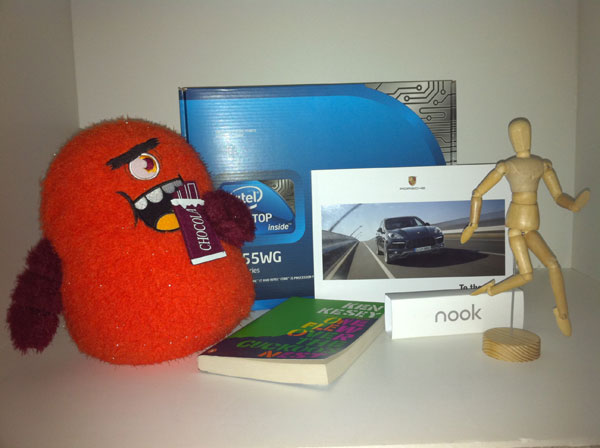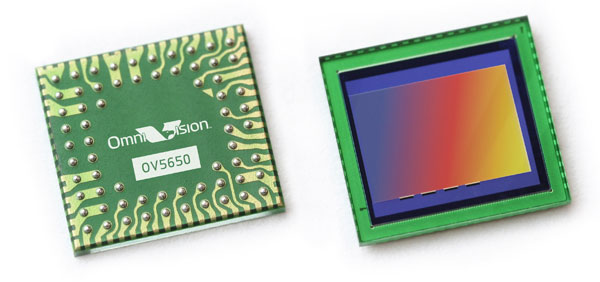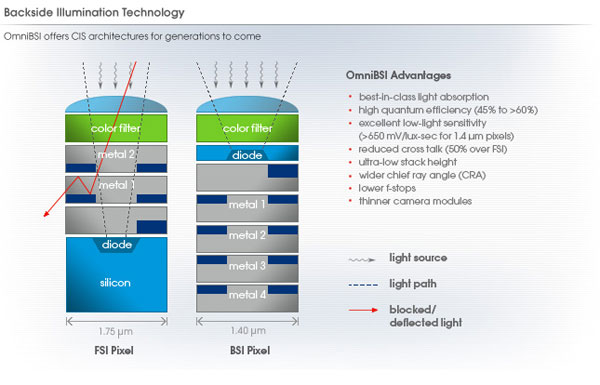Apple's iPhone 4: Thoroughly Reviewed
by Brian Klug & Anand Lal Shimpi on June 30, 2010 4:06 AM EST- Posted in
- Smartphones
- Apple
- iPhone 4
- Gadgets
- Mobile
Welcome to 2010, Apple Upgrades its Camera
The iPhone 4 is equipped with two cameras: a 5 megapixel camera with LED flash on the back of the phone and a VGA camera with no flash on the front. The LED flash works in both still and video modes. Like the EVO 4G, the iPhone 4‘s flash allows you to shoot in perfect darkness. If you’re filming a video in low light the LED will stay illuminated while you’re recording.

Taken with the iPhone 4 in total darkness
The same unfortunately can’t be said for the front facing camera on the 4. In anything but good lighting you’re going to get noise. It’s really only useful for FaceTime (or as an alternative to a mirror) and even then you need to be well lit for it to look decent.
Apple has opted for a 5 megapixel OmniVision sensor for the rear camera on the iPhone 4. What's interesting is that Apple has decided to bring backside illumination front and center with their marketing.
Backside illumination improves the sensitivity of CMOS and CCD detectors by reducing the amount of material in the path of incident light. In a frontside illuminated detector, a considerable amount of light is lost due to absorption that doesn't result in emission of an electron, in addition to reflection off pixel structures and electrical components near the frontside surface. Backside illumination greatly improves sensitivity by flipping the stack over. Instead of light having to pass through and possibly be reflected by metal structures, it is converted into electrons and read out by passing solely through silicon. Creating a backside illuminated part isn't as simple as flipping a sensor over, however, as manufacturers also generally thin the silicon light has to pass through before it can reach the photodiode. This further improves sensitivity and is generally accomplished through chemical etching in acid or by lapping (physically grinding) sensors at wafer scale.

OmniVision OV5650 - iPhone 4's rear camera SoC
Though backside illumination (BSI) improves quantum efficiency (how many photons are converted into electons), backside illumination is hugely important for another serious reason as well. Because the sensor is small at 4.6 mm by 3.4 mm, pixel size is also extremely small at just 1.75 microns square for the OV5650 in the iPhone 4 (state of the art sensors are 1.4 microns square, like those in the HTC Incredible's 8 MP sensor). Frontside illuminated parts generally have in the neighborhood of 10-15 microns of silicon before the active region of the photodiode where one wants photons to get converted to electrons. The result is that without backside illumination, pixels have a 10:1 ratio of height to length, you can visualize them as looking something like long square pillars. But that's a problem.
As photons are converted into electrons in that silicon, there's no guarantee that it will immediately travel down into the gate structure below to be read out by the camera. Electrons drift as they descend these columns, meaning that photons incident on one pixel don't necessarily map to the gate below. Because the smartphone camera sensors are so small, with a 10:1 ratio of height to size, the result is large amounts of so-called quantum blurring from electrons traveling into the gate structures of adjacent pixels. The result is a blurry image (and a decrease in MTF at the sensor level!), thus not representing the image that used to be incident on the sensor.
OmniVision and other smartphone CMOS sensor manufacturers thin that column down in an effort to come closer to having the pixel look more like a cube than a huge pillar. Ballpark numbers are between 3 and 6 microns, down from 10-15. The result is much more sensitive sensors that are higher resolution. While megapixels don't necessarily matter, neither does pixel size as much anymore; it's all about quantum efficiency, which is what engineers really care about.

OmniVision BSI - Courtesy OmniVision
The optical system of the iPhone 4 is difficult to characterize without disassembly, though the focal length is a bit shorter than previous iPhones. The result is that the photos are demonstrably wider angle. Backside illumination also allows for a bigger chief ray angle, higher numerical aperture (and thus lower f/#), but I won't bore you with the details.










270 Comments
View All Comments
Thorvald - Wednesday, June 30, 2010 - link
I understand that you aren't trying to stab at iOS4, but some of these really seem to be a stretch. For example, the iPhone 3G is just about two years old. What two-year old Android phone is running the latest OS with full feature parity as brand-new phones?I am quite sure that someone (with more time on their hands than me) could come up with an equally long list of points where Android falls short of iOS4, especially if we are going to be nitpicky about it.
It would be more nice if there were ways to objectively measure quality of user experience. Specific features are something that can be listed, but implementation counts too.
Spoelie - Wednesday, June 30, 2010 - link
You have to understand that that list was NOT originally compiled as a comparison to Android but was the negative part of a "what can you expect with this upgrade" (positives vs negatives) list. The iOS4 upgrade is offered on the 3G and that's why the point has merit: what does the upgrade mean for 3G users?However I concur it can read as a comparison since most of these points are Android features on SOME phones (social networking integration for example is mostly part of the proprietary custom UIs like HTC Sense and TouchWiz and not part of Android itself).
Personally, since I do have an Android phone, it reads more like a "what would I miss if I made the switch" list. But only some of the points.
darwinosx - Wednesday, June 30, 2010 - link
Thats a really idiotic list composed by someone who knows nothing about iPhones.-Anyone who wants flash on a mobile device is not paying attention.
-Comments on IOS4 on the 3G are silly. Especially since Apple says its not supported except on the 3GS and 4. Funny how they don't comment on how many Android phones are still on 1.6 and will never be upgraded including some pretty new phones.
-"True' multi-tasking? I don't think they understand how Android multi-tasking works. It's certainly not "true" multi-tasking as on a desktop os. It's also highly inefficient and a major cause of poor Android phone battery life.
-Android phones have widgets, which are intrusive and resource consuming because the stock Android OS UI is so awful.
-There are plenty of ways to USB mass storage with the iPhone.
-You can mass mark e-mails as read.
-There are plenty of ways to access the file system not that 99% of users will ever want to.
-You don't need vibration feedback when touching the screen because the iPhone screen, unlike many Android phones, actually reacts easily to touch.
-You can do bluetooth file transfers.
-SMS/MMS has multiple delivery notifications.
-I play Xvid and Divx all the time and there are multiple third party apps for that.
-You can add to the iPhone from other apps including Double Twist and others.
Truly an idiotic list.
bplewis24 - Wednesday, June 30, 2010 - link
Whether or not the list is idiotic, you just solidified your own standing with this post. I'm not sure why I even bothered posting to such an idiotic retort.Brandon
mesiah - Thursday, July 1, 2010 - link
lmao, not to sound like an android fanboy, or even an apple.... haterboy (hmmm new term there.) But your reasoning for alot of those missing features just further backs up the apple fan stereo type.Any time an apple device lacks a feature its because "That feature is not needed.' "That feature is useless." or how about "Anyone who wants ___ isn't paying attention."
But when the next gen phone comes out, and it finally does have those features. You know, the ones everyone else already had and you said you didn't need. You know, like... a camera. You then talk about how your new feature reinvents the phone its self. How "no one has ever done it like apple did."
Seriously, its pathetic. I know every phone out there has flaws. I also know there are plenty of things apple gets right with the iphone. I will even go as far to admit that smart phones wouldn't be where they are today if it weren't for the iphone. But you people need to admit when you are missing features you should obviously have simply because the all knowing Steve doesn't think you need them. But then again, coming from a company that can admit no wrong, even when their products have a serious design flaw such as the new antenna issue, I can't really expect the followers to act any differently than the ceo.
"If you want flash you aren't paying attention. If your reception went through the basement you don't know how to hold a phone. And if the AT&T network sucks its because you and all the other people are actually trying to use it."
strikeback03 - Thursday, July 1, 2010 - link
One of my friends on facebook posted a screenshot of one of iOS4's great new features......you can change your wallpaper. Really?
bregalad - Wednesday, June 30, 2010 - link
-There are two main reasons to keep Flash off mobile devices: battery life and mouse-overs, a commonly used Flash feature that doesn't work on a touch OS. Given the choice between incomplete support for a resource intensive plug-in and all-day usefulness I'll take that all-day battery life.-Multitasking approaches still up for debate
-iOS 4 runs slowly and lacks features on older hardware - agreed, but does Android do any better? Does your carrier even allow you to upgrade your OS or do you have to get a new phone?
-Given how much battery life iOS 4 stole from me I really wish there were quick toggles
-I don't live in any social network. I rarely even launch the facebook app.
-Something akin to home screen widgets would be very nice
-Every iPhone and iPod touch has the same sounds, it's terrible in an office with lots of them.
-Agreed on the mass marking as read
-Access to the file system is another thing Apple is philosophically opposed to. The iPhone is supposed to be an appliance not a computer.
-Early iPods had disk mode which was very useful. I wish Apple wouldn't be so inflexible.
-You want tactile feedback and all day battery life? Maybe next decade.
-File transfers assumes you have access to the file system and aren't trying to transfer DRM'd files. Not going to happen.
-I don't know about you, but I've never needed to mass delete contacts from any phone or computer. Do you suffer from multiple personality disorder?
-Better notifications of all types would be welcome.
-Smart dialling would be a good feature addition
-An app whose sole purpose is to play "illegally" downloaded files. Yeah, Steve's going to approve that one 'real soon now'.
-The dependency on iTunes is a philosophical one. Steve believes your computer is your digital hub, that it contains the master copy of all your stuff. By definition your phone, with its limited storage capacity, contains a subset of that data. I think that makes sense for the vast majority of the public. You're a niche Apple doesn't want to deal with.
Griswold - Wednesday, June 30, 2010 - link
Must be nonsenseday today.And before you say it, yes I got a 3G and I will replace it with a i4 when they're available around here instead of an android phone as I originally planned, but for other reasons than the fictional ones you just stated.
Bateluer - Wednesday, June 30, 2010 - link
Agreed, there are several Android phones that are out now that offer parity with the iPhone 4, and several within 2 months of release that will handily surpass it.As usual, Anand's reviews were very well written and detailed, but I'll still pit my year old Moto Droid against any iPhone product. :p
JAS - Wednesday, June 30, 2010 - link
As Anand pointed out in his review, the Google/Android operating system feels more like using a computer; and the iPhone (iOS 4) operating system feels more like an appliance. The Android OS is apt to appeal more to the geek than to the "normal mainstream consumer," just as Microsoft Windows is a favorite of people who like to tinker with their computers.For better or worse -- each person has to make their own judgment -- Apple's products are defined as much by features that are purposefully withheld as by the cool innovations that are added.